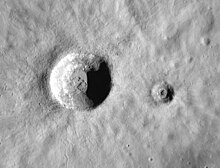
Archimedes is a large lunar impact crater on the eastern edges of the Mare Imbrium. Its diameter is 81 km.

Pupin is a tiny lunar impact crater located in the eastern part of the Mare Imbrium. It was named after Serbian-American physicist Mihajlo Pupin. It lies to the southeast of the crater Timocharis, and was identified as Timocharis K prior to being renamed by the IAU. The mare near Pupin is otherwise devoid of significant impact craters, and is nearly featureless except for a faint dusting of ray material.
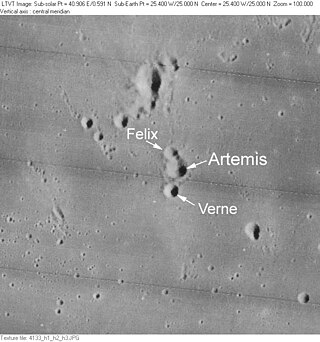
Artemis is a tiny lunar impact crater located in the Mare Imbrium. Craters of this dimension typically form cup-shaped excavations on the surface of the Moon. It lies near the midpoint between the craters Euler to the west and Lambert to the east. Just a few kilometers to the southeast is the even smaller Verne.

Brayley is a lunar impact crater located in the southwest part of the Mare Imbrium. It was named after British geographer Edward W. Brayley in 1935. It has a circular rim and a low rise in the center. There are no notable craters overlapping the rim or interior. The sinuous rille Rima Brayley passes to the north of Brayley.

Carlini is a small lunar impact crater located in the Mare Imbrium. It was named after Italian astronomer Francesco Carlini. The crater is bowl-shaped with a small central floor. It has a higher albedo than the surrounding mare, making it prominent due to its isolated location. To the south is a wrinkle ridge named Dorsum Zirkel, and farther south lies the peak Mons La Hire.

Draper is a small lunar impact crater in the southern part of the Mare Imbrium. It is a circular, cup-shaped formation, with a tiny craterlet intruding into the northeastern rim. To the north-northeast is the crater Pytheas, and to the south lies the Montes Carpatus range. Just to the southeast is the slightly smaller crater identified as Draper C. The crater is named after American astronomer Henry Draper.

Huxley is a tiny lunar impact crater located in eastern inlet of Mare Imbrium, just to the north of the Montes Apenninus. It was named after British biologist Thomas Henry Huxley. To the southeast in this range is Mons Ampère. This crater was previously identified as Wallace B before being renamed by the IAU. The crater Wallace lies due west.
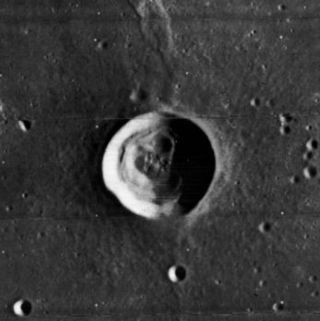
C. Herschel is a small lunar impact crater that lies on the western part of Mare Imbrium. It is named after German astronomer Caroline Herschel. It is a circular, bowl-shaped formation that has not undergone significant erosion. The interior floor has the same low albedo as the surrounding lunar mare. To the south-southwest is the similar crater Heis. C. Herschel lies on a wrinkle ridge of the lunar mare named the Dorsum Heim.

Delisle is a small lunar impact crater in the western part of the Mare Imbrium. It was named after French astronomer Joseph-Nicolas Delisle. It lies to the north of the crater Diophantus, and just to the northwest of the ridge designated Mons Delisle. Between Delisle and Diophantus is a sinuous rille named Rima Diophantus, with a diameter of 150 km. To the northeast is another rille designated Rima Delisle, named after this crater.
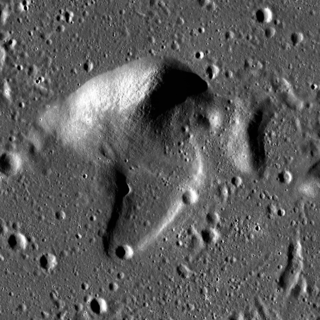
Fedorov is a lunar geologic feature located in the western Mare Imbrium named after Russian rocket scientist Aleksandr Petrovich Fedorov. It lies east-northeast of the crater Diophantus, and southeast of Delisle. About 20 kilometers to the south-southeast is the slightly larger formation of Artsimovich.
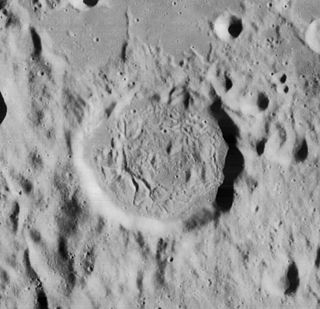
La Condamine is a small lunar impact crater that is located on the southern edge of the Mare Frigoris, in the northern part of the Moon. It lies to the northeast of the mountain-rimmed Sinus Iridum formation in the northwest part of the Mare Imbrium.

Cayley is a small lunar impact crater that is located in a lava-flooded region to the west of Mare Tranquillitatis. It was named after the 19th-century English mathematician Arthur Cayley. It lies to the northwest of the smaller crater De Morgan and the larger D'Arrest. West and slightly north of Cayley is Whewell, a crater of about the same dimensions. To the north is a linear rille designated Rima Ariadaeus, which follows a course to the east-southeast.

Santos-Dumont is a small lunar impact crater that lies in the northern end of the Montes Apenninus range at the eastern edge of the Mare Imbrium. It is located about 30 kilometers to the northeast of Mons Hadley, a mountain massif.

Drude is a lunar impact crater that lies on the far side of the Moon, in the rugged Montes Cordillera range that forms the outer ring around the Mare Orientale impact basin. It is located just behind the west-southwest limb, and this area is sometimes brought into sight from Earth during favorable librations. However, even at such times, the crater is viewed from the edge and little detail can be seen.

Feuillée is a small lunar impact crater in the eastern part of the Mare Imbrium. It was named after French natural scientist Louis Feuillée. It lies less than a half crater diameter to the northwest of Beer, and the two formations form a nearly matched pair. To the west is the small but prominent crater Timocharis.

Bliss is small lunar impact crater that is located just to the west of the dark-floored crater Plato. It lies in a region of continental terrain between Mare Imbrium to the south and Mare Frigoris to the north. This crater is bowl-shaped, with a small interior floor at the midpoint and a somewhat eroded outer rim.

Courtney is a tiny lunar impact crater on the Mare Imbrium, a lunar mare in the northwest quadrant of the Moon. It lies about two crater diameters to the northwest of Euler, in an otherwise isolated stretch of the mare. The dark surface in this region is marked by Euler's ray material. The name is an English male name.

Mons La Hire is a solitary lunar mountain in the western Mare Imbrium. It is located to the northeast of the crater Euler, and to the west-northwest of Lambert.

Mons Vinogradov is a rugged massif that is located on the lunar mare where Oceanus Procellarum to the southwest joins Mare Imbrium to the east. There are three primary peaks in this formation, which rise to altitudes of 1.0–1.4 km above the surface. To the east of this rise is the crater Euler, and to the southeast is an area of rugged ground that reaches the Montes Carpatus range. The Carpatus mountain range forms the southwest boundary of the Mare Imbrium.

Cassini is a lunar impact crater that is located in the Palus Nebularum, at the eastern end of Mare Imbrium. The crater was named after astronomers Giovanni Cassini and Jacques Cassini. To the northeast is the Promontorium Agassiz, the southern tip of the Montes Alpes mountain range. South by south-east of Cassini is the crater Theaetetus. To the northwest is the lone peak Mons Piton.





